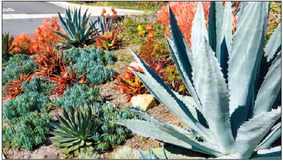Drought Update


California’s drought is not likely to end with this winter’s rains, according to forecasters. There’s less than a 40 percent chance of water supplies getting back to normal after this winter, with a slightly better than 50 percent chance that the state’s drought will worsen, according to information released last week by the National Integrated Drought Information Center.
The center is led by the National Oceanic and Atmospheric Administration.
The record atmospheric river storms that pelted Northern California in late October helped a bit, but water levels at major reservoirs remain far below normal, and La Niña conditions increase the likelihood of Southern California having a drier, warmer winter than is usual.
“The drought has been built over years, and autumn storms do not necessarily mean the rest of the winter will be wet,” said Amanda Sheffield, the region’s coordinator for the drought center.
All of California is enduring moderate to exceptional drought, with 80 percent of the state at the two highest levels of “extreme” and “exceptional.”
Seal Beach ranks marginally better than the rest of the state, with 100 percent of Orange County under moderate drought. The greater Los Angeles area is under a “severe” drought.
But while Southern California ranks a bit better than the rest of the state, it failed to get much direct benefit from October’s atmospheric river, aside from a dampening of brush to temporarily lower the risk of wildfire. The area is still relatively dry and warmer than normal. That’s expected to continue at least through early winter, thanks in part to La Niña, a weather pattern that typically includes warmer oceans, less precipitation in Southern California and more precipitation in Northern California. But that forecast becomes less certain after the beginning of the year.
“These odds are really quite modest,” said Jon Gottschalck of the National Weather Service’s Climate Prediction Center.
The Metropolitan Water District, which manages Southern California’s water imports from Northern California and the Colorado Rivers, started off the year with more water in storage than ever before, thanks to increased storage capacity and increased conservation efforts. But while the drought has hit Northern and Central California the hardest, the southern part of the state also is starting to feel the effects of drought.
The California Department of Water Resources has said there would be no initial December allocation of water for Southern California from the State Water Project because of record low storage levels in the reservoirs that store water from Northern California. The Metropolitan Water District on Nov. 9 declared a drought emergency, focused particularly on six agencies spread across Los Angeles, Ventura and San Bernardino counties that are dependent on the water from the state project. But everyone is being asked to voluntarily cut back on water use. The Metropolitan Water District, which supplies water to 19 million people through 26 service agencies in the region, reports that the past two years have been the driest two-year sequence on record.
The October rain helped moisturize the soil in Northern California. The more water content in the soil when the snow starts melting next year, the more of that snowpack ends up in reservoirs and aqueducts rather than being soaked up by the ground.
That could help but more is needed. LW residents should do everything they can now to conserve the precious resource. On average, up to 60 percent of the water Californians consume is used outdoors. But there are things you can do to save.
In the yard:
• Use Water-wise Plants in Gardens
Check with your local water agency on the best plants for your area. It is best to use waterwise, California-native plants when possible.
• Report leaky sprinkler heads
Let your Mutual director know if you see leaky sprinkler heads A leak about as small as the tip of a ballpoint pen can waste about 6,300 gallons of water per month.
• Cleaning Outdoors
Using a broom to clean outdoor areas can save 6 gallons every minute.
• Use Mulch Using mulch in your garden can save 20–30 gallons of water per 1,000 square feet each time you water.
Around the house:
• Fix leaky pipes
Fixing leaks inside and outside the home can save 27-90 gallons of water each day.
• Install High-Efficiency Toilets Installing high-efficiency toilets can save 6-35 gallons per day.
• Watering indoor plants Recycling indoor water to use outdoors can cut water use by 30 percent.
• Shorter Showers Keeping showers under 5 minutes can save 12.5 gallons per shower when using a waterefficient showerhead.
• Turn Off Water When Brushing Teeth, Shaving
By turning off the water when brushing teeth or shaving, you can save 8 gallons of water per person per day.
• Wash Full Loads of Clothes and Dishes
Saves 15-45 gallons per load by washing at full capacity. A full dishwasher saves 5-15 gallons per load.



